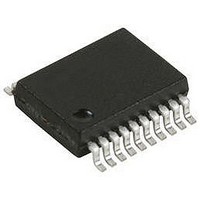USB-SPI-SS HEXWAX, USB-SPI-SS Datasheet - Page 2

USB-SPI-SS
Manufacturer Part Number
USB-SPI-SS
Description
IC, USB TO SERIAL SPI INTERFACE, SSOP-20
Manufacturer
HEXWAX
Datasheet
1.USB-SPI-DIL.pdf
(9 pages)
Specifications of USB-SPI-SS
Supply Voltage Range
1.8V To 5V
Digital Ic Case Style
SSOP
No. Of Pins
20
Termination Type
SMD
Package / Case
20-SSOP
Filter Terminals
SMD
Rohs Compliant
Yes
Lead Free Status / RoHS Status
Lead free / RoHS Compliant
Basic Operation
To the electronic system (‘device’), USB-SPI looks like a
SPI serial slave device. To the PC (‘host’), it looks like a
Human Interface Device (HID) with which it may
exchange information using simple commands.
Using the HID USB profile means that no driver
installation is required and immediate compatibility is
assured
Additionally, software can find the device automatically
without needing to know which virtual COM port it is
occupying.
Pin Functions
The pin functions are shown in table 2. The function of
the virtual I/O pins is reconfigurable, so their default
settings are also shown. Note that the output pins are in
a tri-state condition until ~20μs after power-on.
The pin functions are described in detail below.
Vss, Vdd, Vusb
Vss is the power supply ground reference. Vdd should
be connected to a regulated supply, for example the
USB bus power.
470nF capacitor, to Vss. See for example C8 in figure 2.
OSC1, OSC2
OSC1 and OSC2 should be connected to a 12MHz
parallel cut crystal circuit with 22pF capacitors. It may
be replaced with a 12MHz resonator with 0.25% total
tolerance.
SCK, MOSI, MISO, SS#
SPI serial data I/O. Data is input on MOSI and output
on MISO if SS# is asserted (active low) and the SCK
input is clocked. SPI can be operated in any of modes
“A”, “B”, “C” or “D” (also known as modes “3”, “1”, “2”
p2 of 9
8,19
DIL
11
18
12
22
13
21
17
23
24
14
15
27
16
28
20
10
1
5
6
7
9
SSOP Name Description
10
11
12
13
14
15
16
17
18
19
20
4
5
6
7
8
9
1
3
2
on
VIO10 Virtual I/O / *Rx Buffer Not Full (out)
OSC1 Oscillator output
OSC2 Oscillator input
MISO
MOSI
VIO0
VIO1
VIO2
VIO3
VIO4
VIO5
VIO8
VIO9
Vusb
SCK
PGC
PGD
SS#
Vpp
Vss
Vdd
Windows,
D+
D-
Table 2. Device Pinout
Vusb should be connected, via a
Virtual I/O / *Reset# (in)
TEAclipper Vpp
Virtual I/O / *Tx Ind (out)
Virtual I/O / *Rx Ind (out)
Virtual I/O / *Tx/Rx Ind (out)
Slave Select input (Active low)
Slave serial data output
Virtual I/O / *All-Systems-Go# (out)
Slave serial data clock input
Virtual I/O / *Suspend# (out)
Slave serial data input
Virtual I/O / *Tx Buffer Empty (out)
Virtual I/O / *Send (int)
USB supply filter
USB data -
TEAclipper PGC
USB data+
TEAclipper PGD
Power ground reference
Power positive input
26-Aug-10
Linux
and
* = default configuration
OS
# = active low
USB-SPI
systems.
and “0”, and “1,1”, “0,1”, “1,0”, “0.0”, respectively). Refer
to table 3. The maximum permitted clock rate is 1MHz.
Vpp, PGC, PCD
TEAclipper programming pins.
and Programming section for details. Note that the Vpp
pin may be subject to voltages as high as 12V during
programming.
VIO pins
The VIO pin functions can be reconfigured as detailed in
the customization section.
shown in table 2. The pins can be configured as follows.
No Function
The pin is a digital input that has no effect. To minimize
power consumption, it should be biased high or low.
This setting is available on all VIOs.
Reset
The pin is an active low reset input.
device effectively implements the soft detach function.
This setting is available on VIO0 only.
USB Power Sense
If the device is capable of operating while not plugged
into a USB port, a USB Power Sense input should be
provided.
detected on the V+ pin of the USB connector. It is used
to reduce power consumption by entering into a sleep
mode when the USB is not present, and also to ensure
that the USB engine correctly initializes when the device
is plugged in. The SPI port is not operational during
sleep. This setting must be on VIO9.
Self Power Sense
If the device is capable of operating while not plugged
into a USB port, a Self Power Sense input may be
provided. This pin should indicate when the device is
not drawing power from the USB bus and can help the
PC manage its power budget. This setting is available
on any VIO pin.
Tx Indication
Output for connecting to a transmit indication LED. It
turns on for approximately 100ms when data has been
transmitted to the host. This setting is available on any
VIO pin except VIO0.
MODE CPOL CPHA Description
1,1
0,1
1,0
0,0
A*
C
D
B
3
1
2
0
1
0
1
0
HW144-7
This pin should indicate that a voltage is
1
1
0
0
Table 3. SPI Modes
SCK idle high
Data changes on SCK high-to-low
Data read on SCK low-to-high
SCK idle low
Data changes on SCK low-to-high
Data read on SCK high-to-low
SCK idle high
Data changes on SCK low-to-high
Data read on SCK high-to-low
SCK idle low
Data changes on SCK high-to-low
Data read on SCK low-to-high
The default functions are
Refer to the Delivery
* = default configuration
www.hexwax.com
Resetting the


















